Despite the insidious racism, like a lot of people then, I was hooked on Westerns, one of the great comics genres that have received little attention over the years. My collecting addiction was hugely fuelled by my account at (where else?) the American bank Wells Fargo. An account with Wells Fargo came with a cheque book printed with Western scenes. Those cheques corralled a great many Western comics, and I often went after odd and offbeat items in search of good art, rough justice and a wealth of idiosyncratic frontier dialogue wrapped up in fast moving narrative.

Western Adventures was a splendidly wild comic, but one I can’t reread or show about much because it’s a ‘high-baked item’. Sadly, it was left alongside a radiator for decades, and the poor-quality paper crumbles a bit more every time a page is turned.
But just look at the vibrant Cross-Draw Kid for example – he leaps, rolls, spins and almost flies like Superman in his no-nonsense pursuit of justice against “The Skull”:
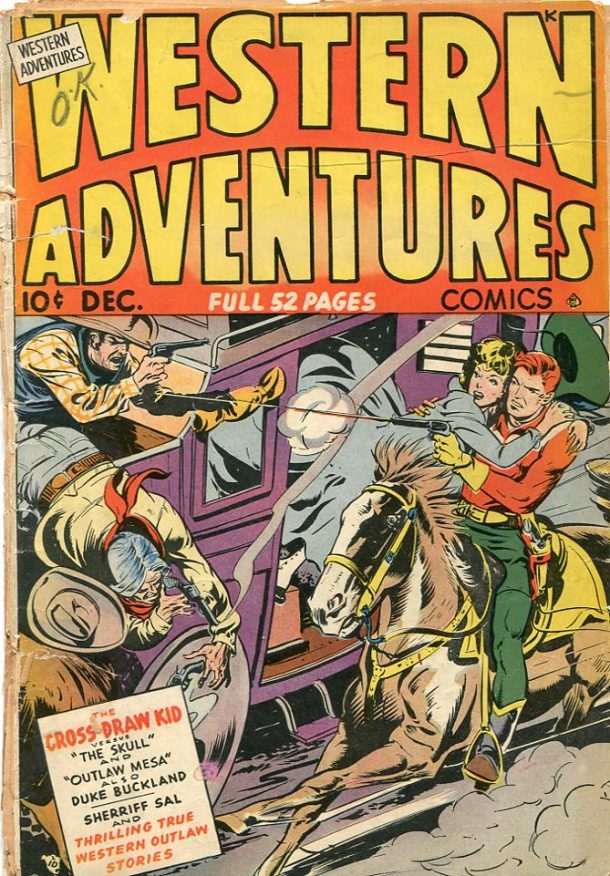
Or Sam Brown, The Barbarous Bully, which takes lavish liberties with history, but still makes a compelling read. The example below is a superb splash page – rough and ready, from start to finish with thickly drawn lines and fast moving frames. The ‘true’ story of Sam Brown was a nod to the notorious outlaw and train robber, Sam Bass, who had a similar penchant for brutality, but Brown the Barbarous Bully is not saved by the change of name – he still gets his just deserts…
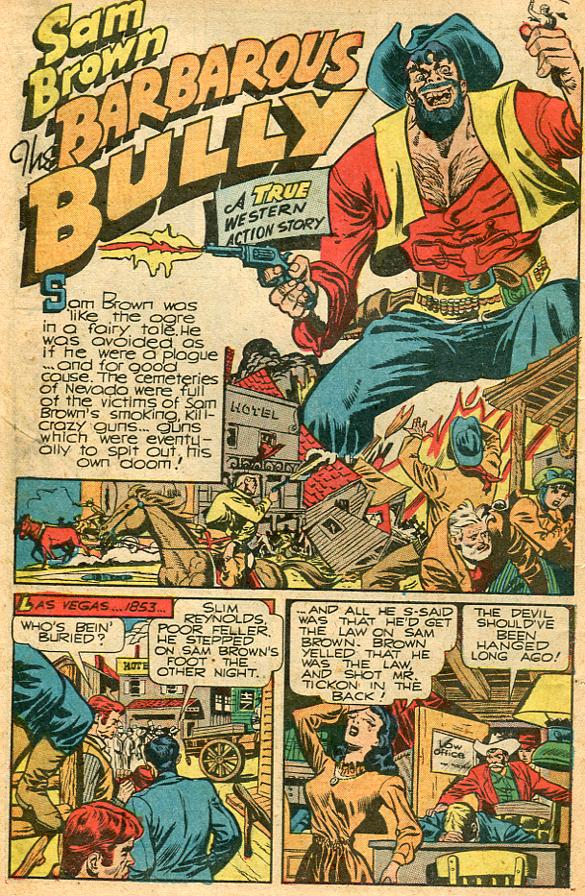
I was constantly looking out for the rare female Western stories – they were few and far between. Sheriff Sal was a great one. Victimised by gender prejudice, she comes through as a character with great force, with a line drawn less heavy and another splash page with an appropriately dramatic angle. In this page, Sally Starr (her surname filched from Brenda Starr, a character in the first syndicated newspaper strip to be drawn and written by a woman,1941) is tricked out of town and accused of being wrongfully off duty during a bank robbery.
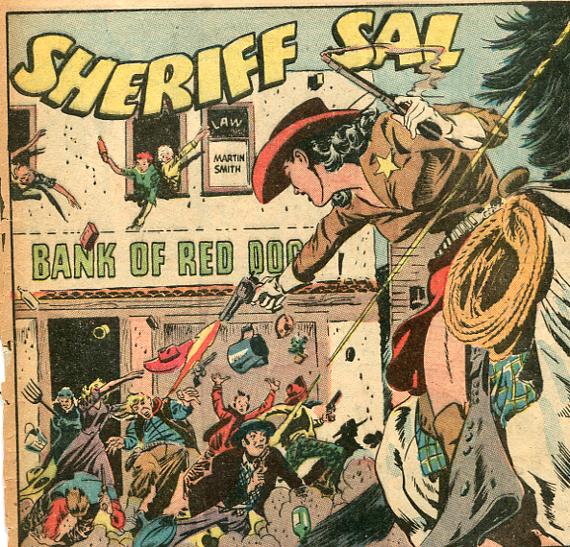
Though, sworn to uphold justice, she still wasn’t immune from the occasional proposition to settle down “like a self-respectin’ female should”:

Tex Granger came out of a movie serial taking over from a magazine. It was commonplace for a comic to change its spots so as to make savings on postal service charges. This comic graphically presents something not too common and much to my liking. It is slightly bigger – almost magazine-sized – and the frames are sparse with minimal background detail. The dialogue is never overbearing; a fine balance between word and image, and it resonates with echoes of the Prohibition-era stories of Damon Runyon. The look is certainly more twenties than forties, and that also is appealing. It’s the flavour of the epic dimension, and an appealing depiction of character. Here, Billy the Kid has flitted a long way from the usual depiction of the heroic outlaw bandit. He’s bad-goods, and he’s got a mean face:
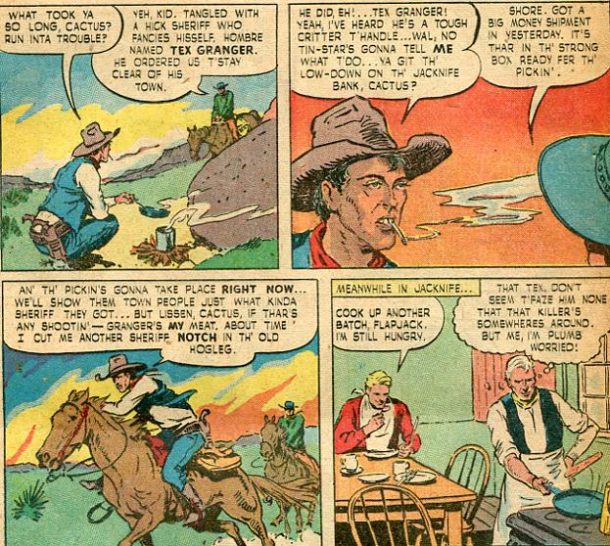
Many of the frames are so composed they arrest the moving eye to linger and look more fully. There’s a certain casual delicacy with few solid lines. Often the line is breaking apart adding to the prevailing look of authenticity. Look at the magnificent curve of the whip, and the the snap of the gun hand in the exquisite frame at the top left. One can almost feel the sting of the whip and the ping of the gun:

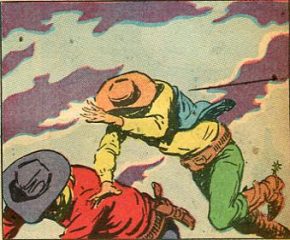
Western Comics was churned out with regular fare, adventure and high jinks, and with sporadically lively dialogue (‘close yore bazoo and elevate those paws!’). All this from unsigned quality artists, who subsequently went on to make their mark in the comics industry. In that era few artists got a credit. Nowadays they are recognised by name and and identified by their individual style.
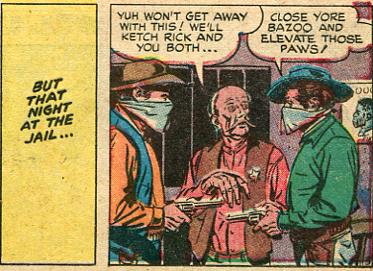
As ever, the lettering is all upper case. Amongst the various bits and pieces is a guide to cowboy argot; with a big tongue in lots of cheek. Webster it ain’t! Yet another Western dictionary – a thumbnail reference sketch with translation.
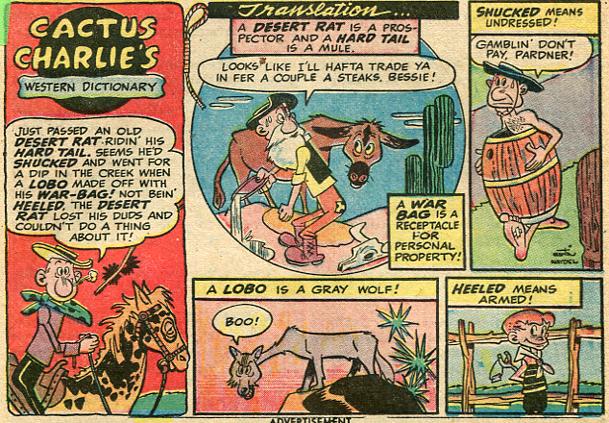
I always felt that the Westerns published by DC comics seemed less at ease, less homogenous and probably flying too far away from the superhero genre they were comfortable with, and which was the even then the bastion of that publishing house. I never felt DC comics produced very satisfying Western stories. One great pleasure was when an issue had one long story broken up into chapters. I felt that with all the genres. DC inherited Hopalong Cassidy out of the spoils of the fight of the century when DC’s Superman took Fawcetts’s Captain Marvel to the cleaners. I liked Hopalong, especially when rendered by Dan Spiegle, who made a career out of transforming movies and serials into the comic book format. William Boyd, the Hopalong actor was a shrewd cookie. He procured all the rights to his movies and made a fortune.
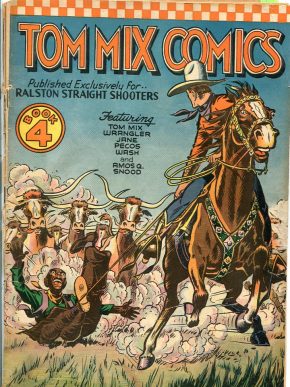
Dating back to the silent era, Tom Mix was the most elegant of all the cowboy movie stars: huge Stetsons, long coats, a fine horse, a swanky roadster and enough guts to do his own stunts (which killed him in the end). His career lasted from 1920 until 1935, and at the peak of his career was paid more than any Western star.
Tom Mix starred in comics published by a number of publishers, Fawcett included, but he also appeared in his own series of comics published by Ralston Cereals. This early 1940s issue above is particularly difficult to read through today. Not sold publicly, and only available by mail order (for two coupons to be cut out of the back of a cereal box), it is full of stereotypically racist dialogue – the cover shows Wash, the black comedic caricature sidekick, rescued from a stampede by Tom, dragged along behind Tom’s horse. Of course, this was brought out at a time when the American armed forces were still segregated, something that changed only in 1949. On the radio, Tom and Wash advertised Ralston cereals together. The voice of Wash was quite obviously played by a white actor pretending to be black, the stereotypical dialogue continuing in the pages of the comic, as you can see below. Go figure. It’s perhaps a distasteful reminder of the notorious casting procedure in the much earlier silent film of Birth of a Nation (1915). In the crowd scenes, if a black character appeared to be speaking on camera, a blacked-up white actor was required to do the job.
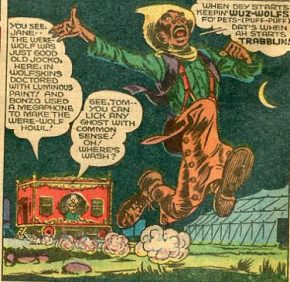
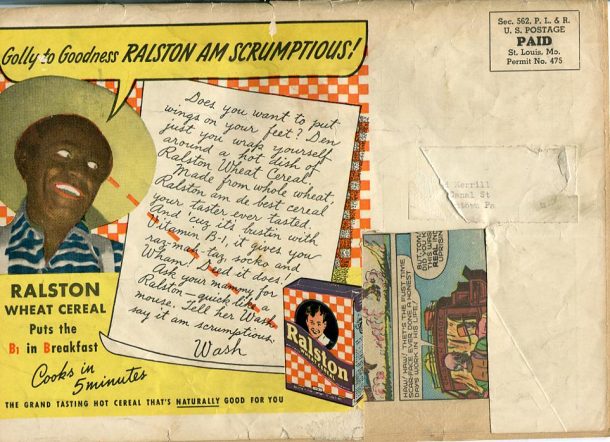
In contrast to the black characters, in general, native American characters were portrayed in a much less sterotyped fashion in comics. The Lone Ranger’s sidekick, Tonto, was usually portrayed as dignified, and humane, with distinctive moral awareness and acumen. The occasional stories involving white characters often reduced the quality of the writing on a number of levels, though never the art. A white presence usually lowered the quality of dialogue and elevated the cliché. The narrative became stilted and clunky, but even then, the heroic drama went on undiminished.

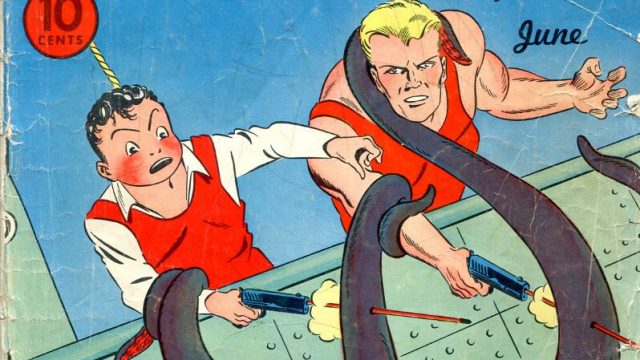
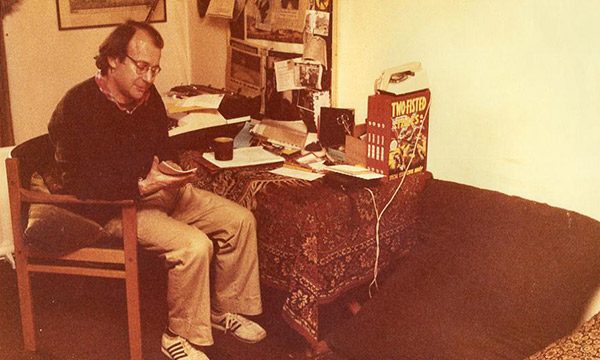
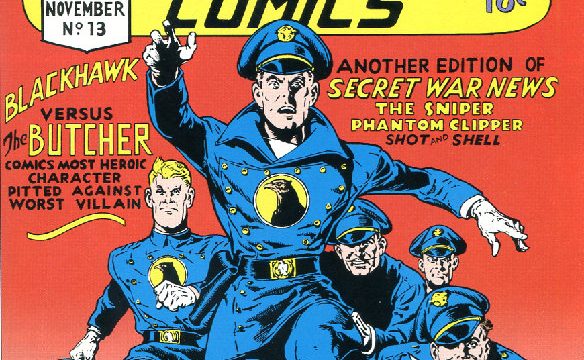
Ian, I have been trying to get in touch you. Please pass this on to Ian, Thank you, Sel